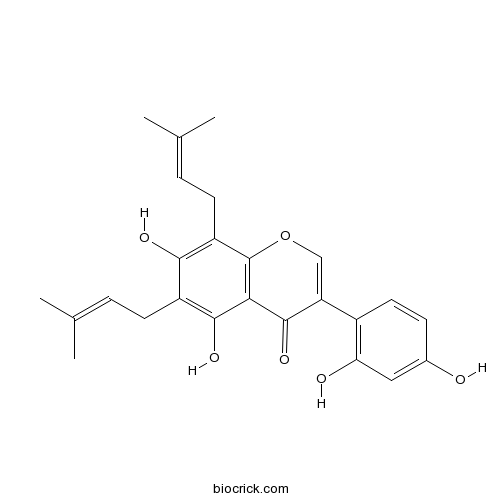8-PrenylluteoneCAS# 125002-91-7 |

Quality Control & MSDS
3D structure
Package In Stock
Number of papers citing our products

| Cas No. | 125002-91-7 | SDF | Download SDF |
| PubChem ID | 471687 | Appearance | Powder |
| Formula | C25H26O6 | M.Wt | 422.5 |
| Type of Compound | Flavonoids | Storage | Desiccate at -20°C |
| Solubility | Soluble in Chloroform,Dichloromethane,Ethyl Acetate,DMSO,Acetone,etc. | ||
| Chemical Name | 3-(2,4-dihydroxyphenyl)-5,7-dihydroxy-6,8-bis(3-methylbut-2-enyl)chromen-4-one | ||
| SMILES | CC(=CCC1=C(C2=C(C(=C1O)CC=C(C)C)OC=C(C2=O)C3=C(C=C(C=C3)O)O)O)C | ||
| Standard InChIKey | VYELCIXMHUBNAL-UHFFFAOYSA-N | ||
| General tips | For obtaining a higher solubility , please warm the tube at 37 ℃ and shake it in the ultrasonic bath for a while.Stock solution can be stored below -20℃ for several months. We recommend that you prepare and use the solution on the same day. However, if the test schedule requires, the stock solutions can be prepared in advance, and the stock solution must be sealed and stored below -20℃. In general, the stock solution can be kept for several months. Before use, we recommend that you leave the vial at room temperature for at least an hour before opening it. |
||
| About Packaging | 1. The packaging of the product may be reversed during transportation, cause the high purity compounds to adhere to the neck or cap of the vial.Take the vail out of its packaging and shake gently until the compounds fall to the bottom of the vial. 2. For liquid products, please centrifuge at 500xg to gather the liquid to the bottom of the vial. 3. Try to avoid loss or contamination during the experiment. |
||
| Shipping Condition | Packaging according to customer requirements(5mg, 10mg, 20mg and more). Ship via FedEx, DHL, UPS, EMS or other couriers with RT, or blue ice upon request. | ||
| Description | 1. 8-Prenylluteone can potently inhibit HIV-1 PR activity. |
| Targets | HIV |

8-Prenylluteone Dilution Calculator

8-Prenylluteone Molarity Calculator
| 1 mg | 5 mg | 10 mg | 20 mg | 25 mg | |
| 1 mM | 2.3669 mL | 11.8343 mL | 23.6686 mL | 47.3373 mL | 59.1716 mL |
| 5 mM | 0.4734 mL | 2.3669 mL | 4.7337 mL | 9.4675 mL | 11.8343 mL |
| 10 mM | 0.2367 mL | 1.1834 mL | 2.3669 mL | 4.7337 mL | 5.9172 mL |
| 50 mM | 0.0473 mL | 0.2367 mL | 0.4734 mL | 0.9467 mL | 1.1834 mL |
| 100 mM | 0.0237 mL | 0.1183 mL | 0.2367 mL | 0.4734 mL | 0.5917 mL |
| * Note: If you are in the process of experiment, it's necessary to make the dilution ratios of the samples. The dilution data above is only for reference. Normally, it's can get a better solubility within lower of Concentrations. | |||||

Calcutta University

University of Minnesota

University of Maryland School of Medicine

University of Illinois at Chicago

The Ohio State University

University of Zurich

Harvard University

Colorado State University

Auburn University

Yale University

Worcester Polytechnic Institute

Washington State University

Stanford University

University of Leipzig

Universidade da Beira Interior

The Institute of Cancer Research

Heidelberg University

University of Amsterdam

University of Auckland

TsingHua University

The University of Michigan

Miami University

DRURY University

Jilin University

Fudan University

Wuhan University

Sun Yat-sen University

Universite de Paris

Deemed University

Auckland University

The University of Tokyo

Korea University
- Aminoglutethimide
Catalog No.:BCC4368
CAS No.:125-84-8
- Usnic acid
Catalog No.:BCC8264
CAS No.:125-46-2
- Primidone
Catalog No.:BCC4930
CAS No.:125-33-7
- Vomicine
Catalog No.:BCN6735
CAS No.:125-15-5
- Isobornyl acetate
Catalog No.:BCN8296
CAS No.:125-12-2
- Prednisone 21-acetate
Catalog No.:BCC9128
CAS No.:125-10-0
- Ajugamarin L2
Catalog No.:BCN3662
CAS No.:124961-67-7
- Ajugacumbin A
Catalog No.:BCN3657
CAS No.:124961-66-6
- Raddeanoside R8
Catalog No.:BCN6555
CAS No.:124961-61-1
- Tectoroside
Catalog No.:BCN6672
CAS No.:124960-89-0
- Tolterodine tartrate
Catalog No.:BCC4586
CAS No.:124937-52-6
- (R)-(+)-Tolterodine
Catalog No.:BCC4054
CAS No.:124937-51-5
- Fmoc-D-Ala-OPfp
Catalog No.:BCC3037
CAS No.:125043-04-1
- 8-(3-Ethoxy-2-hydroxy-3-methylbutyl)-7-methoxycoumarin
Catalog No.:BCN1594
CAS No.:125072-68-6
- Epinortrachelogenin
Catalog No.:BCN3719
CAS No.:125072-69-7
- XL388
Catalog No.:BCC2059
CAS No.:1251156-08-7
- 26-Nor-8-oxo-alpha-onocerin
Catalog No.:BCN6131
CAS No.:125124-68-7
- 1-(4-methoxyphenyl)-2-methylpropan-1-one
Catalog No.:BCN8163
CAS No.:2040-20-2
- Rosthornin A
Catalog No.:BCN6132
CAS No.:125164-55-8
- Vibralactone D
Catalog No.:BCN6747
CAS No.:1251748-32-9
- N-Methoxyanhydrovobasinediol
Catalog No.:BCN4856
CAS No.:125180-42-9
- Rosthornin B
Catalog No.:BCN6133
CAS No.:125181-21-7
- 1,7-Bis(4-hydroxyphenyl)hept-6-en-3-one
Catalog No.:BCN6597
CAS No.:1251830-57-5
- Tubastatin A
Catalog No.:BCC2158
CAS No.:1252003-15-8
Two prenylated flavonoids from the stem bark of Erythrina burttii.[Pubmed:12770595]
Phytochemistry. 2003 Jun;63(4):445-8.
From the stem bark of Erythrina burttii, a new isoflavone, 5,2',4'-trihydroxy-7-methoxy-6-(3-methylbut-2-enyl)isoflavone (trivial name, 7-O-methylluteone) and a new flavanone, 5,7-dihydroxy-4'-methoxy-3'-(3-methylbutadienyl)-5'-(3-methylbut-2-enyl)flavanone (trivial name, burttinonedehydrate) along with three known isoflavonoids (8-Prenylluteone, 3-O-methylcalopocarpin and genistein) were isolated. The structures were determined on the basis of spectroscopic evidence.
Prenylisoflavonoids from Erythrina senegalensis as novel HIV-1 protease inhibitors.[Pubmed:19097000]
Planta Med. 2009 Feb;75(3):268-70.
Eight compounds were isolated from the CH (2)Cl (2) extracts of ERYTHRINA SENEGALENSIS to assess HIV-1 protease (PR) activity inhibition. The prenylated isoflavone structures, identified by spectroscopic analysis, were 8-Prenylluteone ( 1), auriculatin ( 2), erysenegalensein O ( 3), erysenegalensein D ( 4), erysenegalensein N ( 5), derrone ( 6), alpinumisoflavone ( 7), and 6,8-diprenylgenistein ( 8). The constituents showed dose-dependent inhibitory activities on HIV-1 PR with IC (50) values from 0.5 to 30.0 muM. Compounds 1 - 5 possessing two hydroxy groups in the 2' and 4' positions of the B ring, potently inhibited HIV-1 PR activity. In addition, 6,8-diprenylgenistein ( 8) with two prenyl groups in the 6 and 8 positions of the A ring and one hydroxy group in the 4' position of B-ring was the most potent HIV-1 PR inhibitor.


